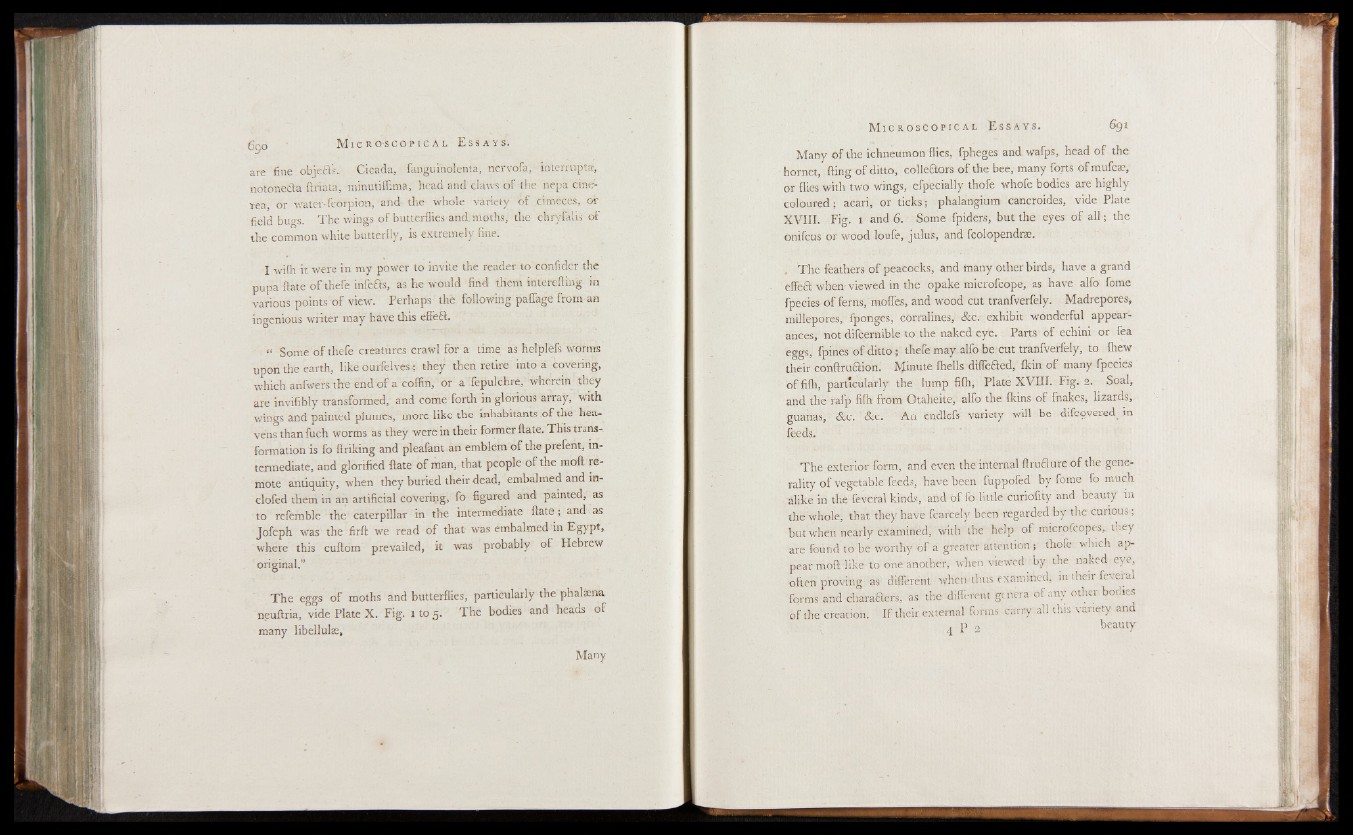
are fine object's. Cicada, fanguinolenta, nervofa, interrupts-,
notoneda ftriata, minutiffima, head and claws of the nepa cmc-
Tea, or water-fcorpion, and- the whole variety of cinieces, or
field buo-s. The wings of butterflies-and. moths, the ehryfells of
the common white butterfly, is extremely fine;
I wifh it were in my power to invite the reader to confider the
pupa ftate of thefe infefts, as he would find them interefting in
various points of view. Perhaps the following paffage from an
ingenious writer may have this effefi.
“ Some o f thefe creatures crawl for a time as helplefs worms
upon the earth, like ourfeives ; they then retire into a covering,
which anfwers the end o f a coffin, or a fepulchre, wherein they
are invifibly transformed, and come forth in glorious array, with
wino-s and painted plumes, more like the inhabitants o f the heavens
thanfuch worms as they were in their former ftate. This transformation
is fo ftriking and pleafant an emblem o f the prefent, intermediate,
and glorified ftate of man, that people of the moft remote
antiquity, when they buried their dead, embalmed and in-
clofed them in an artificial covering, fo figured and painted, as
to refemble the caterpillar in the intermediate ftate; and as
Jofeph was the firft we read o f that was embalmed in Egypt,
where this cuftom prevailed, it was probably o f Hebrew
original.”
The eggs of moths and butterflies, particularly the phalsna
neuftria, vide Plate X. Fig. H0 5. The bodies and heads of
many libellulae.
Many
Many o f the ichneumon flies, fpheges and wafps, head o f the
hornet, ftmg of ditto, collectors of the bee, many forts of mulcac,
or flies with two wings, efpecially thofe whofe bodies are highly
coloured; acari, or ticks; phalangium cancroides, vide Plate
XVIII. Fig. 1 and 6 .' Some fpiders, but the eyes o f a ll; the
onifcus or wood loufe, julus, and fcolopendrae.
I The feathers o f peacocks, and many other birds, have a grand
effefii when viewed in the opake microfcope, as have alfo feme
fpecies- o f ferns, mofles, and wood cut tranfverfely. Madrepores,
millepores, fponges, corralines, &c. exhibit wonderful appearances,
not difcernible to the naked eye. Parts of echini or fea
eggs, fpines o f ditto; thefe may alfo be cut tranfverfely, to ffiew
their conftruaion. Minute {hells diflefted, {kin of many fpecies
o f fifh, particularly the lump fiffi, Plate XVIII. Fig. 2. Soal,
and the rafp fifh from Otaheite, alfo the {kins of fnakes, lizards,
guanas, &c. &c. An endlefs. variety will be difcovered in
feeds.
The exterior form, and even the internal ftruflure of the generality
of vegetable feeds, have been fuppofed by fome fo much
alike in the feveral kinds, and of fo little curiofity and beauty m
the whole, that they have fcarcely been regarded by the curious;
but w h e n nearly examined, with the help of microfcopes, they
are found to be worthy of a greater attention; thofe which appear
moft like to one another, when viewed by the naked eye,
often proving as different when thus examined, in their feveral
forms and charafters, as the different genera of any other bodies
of the creation. If their external forms carry all this variety and
4 P 2 beauty